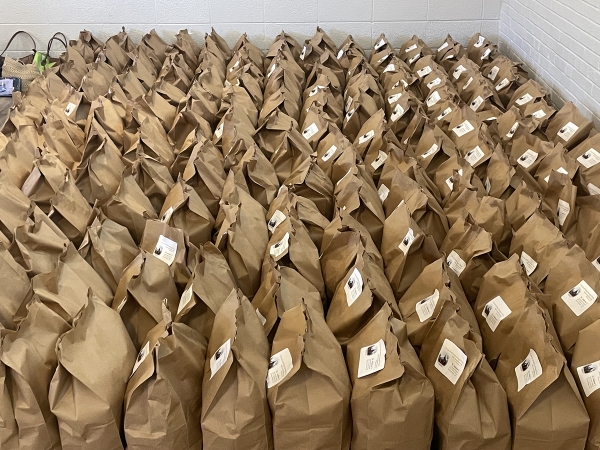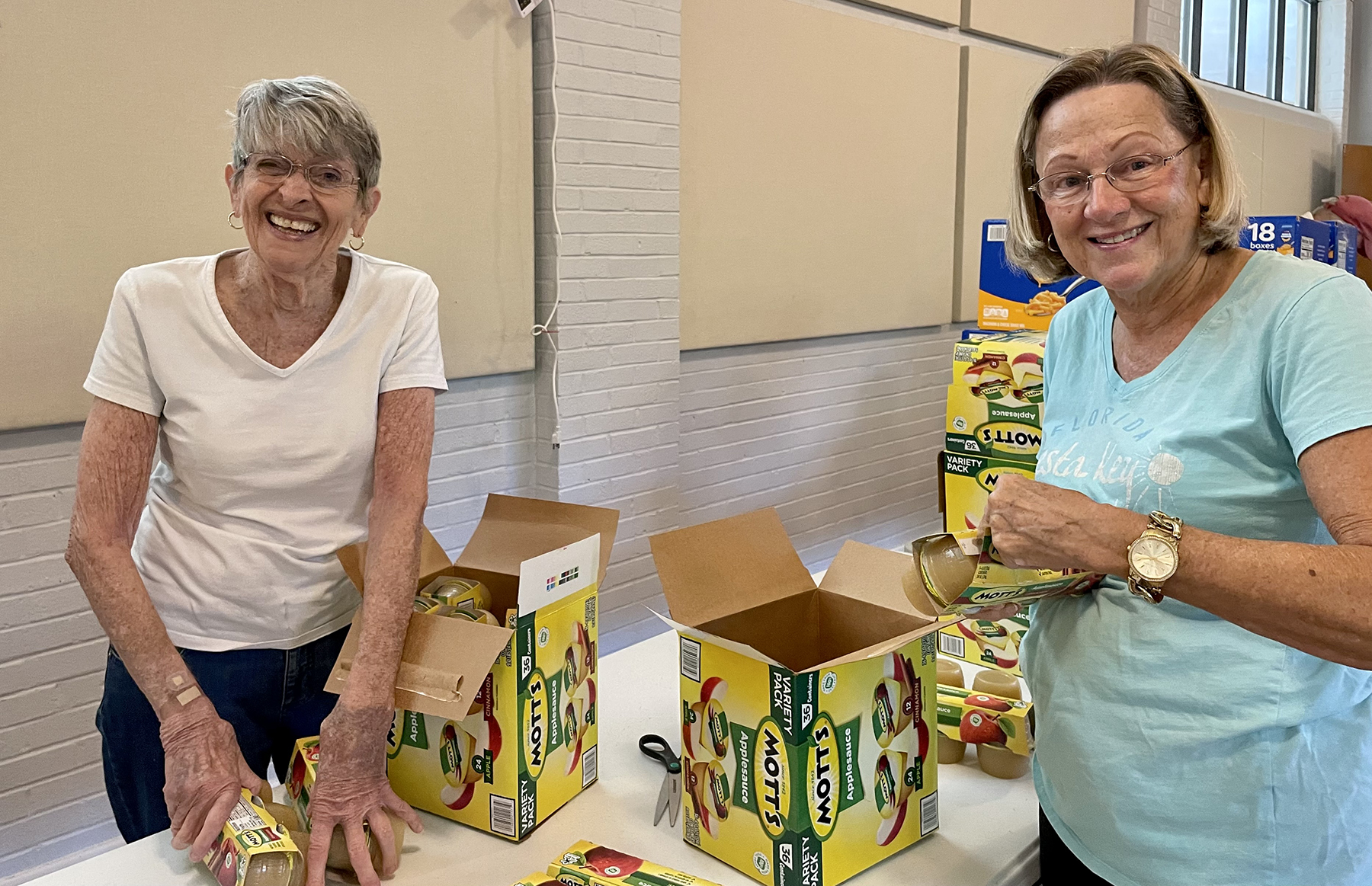Disciple: Commitment, Connections and What They Do Best

St. Andrew’s, Rocky Mount, responds to a community in need after devastating tornadoes
By Christine McTaggart
At midday on July 19, an EF3 tornado touched down in Nash and Edgecombe Counties. With winds of up to 150 miles per hour, in only minutes it cut a path between 12 and 15 miles long and a quarter-mile wide, destroying dozens of homes and doing major damage to the Pfizer manufacturing plant, including its distribution and storage buildings.
Among the areas hardest hit was the town of Dortches, located about five miles from the heart of Rocky Mount and St. Andrew’s. The church was spared damage from the tornado, and immediately thoughts of the parishioners turned to how they could help their neighbors, some of whom had lost everything. The conversation started with a phone call from Pete Armstrong, senior warden, who was in Columbia, South America, at the time.
“St. Andrew’s is without a priest right now,” said Armstrong. “But it’s been extremely important to us that we keep going forward with our mission of helping people. And we saw a need out there.”
The conversation about how to respond began with a question: What are we good at?
That answer was simple.
[Image: Hundreds of food bags packed for distribution. Photos throughout courtesy of St. Andrew’s]
WHAT CAN WE DO
Once a month, St. Andrew’s places a large order for healthy, non-perishable items from a local food warehouse. Parishioners then arrive at the church and, in an assembly line approach, pack bags for the church’s food pantry. Every Tuesday, Wednesday and Thursday morning, those who need the assistance arrive at the church and leave with enough food to give families a good start to fulfilling their needs.
“At first we talked about what could we do,” said Leslie Hall, former senior warden and current chair of the St. Andrew’s search committee. “Our food pantry we kind of have down to a science. We know how to order food. We know how to pack food bags. We have storage places in the parish hall. We decided that with our skill set, food distribution was probably the best thing we could offer. We couldn’t do housing or some of the other things that the people impacted needed. But food was something we could do.”
The food pantry regularly spends about $4,000-5,000 a month on its ministry. To be able to provide emergency provisions for their neighbors affected by the tornado, they realized they were going to need additional resources.
“I basically just researched Episcopal Relief & Development and their efforts and said, well, what the heck! Let’s write a grant and see if we can get some money to provide help to these people, many of whom lost everything,” said Armstrong.
KEEPING IT SIMPLE
Episcopal Relief & Development is a nonprofit of The Episcopal Church. Among its areas of work are disaster response, providing resources and training to prepare for disasters, and assistance to those responding to local communities affected by disasters.
Among the response resources Episcopal Relief & Development provides is emergency funding to help those in impacted communities respond to neighbors. The grants are usually for smaller amounts over three-month periods, and the process to apply is kept intentionally simple. In fact, it is often as simple as a conversation. Members of the responding team contact their diocese, which, in turn, brings in Episcopal Relief & Development, or the team might reach out to Episcopal Relief & Development directly. From there, it’s a conversation with a disaster response program officer to identify the scale and impact of the disaster, as well as the who, what, where and how of the proposed response.
“If you’re in the middle of a disaster, you can’t focus on writing a beautiful grant application,” said Lura Steele, program officer for Episcopal Relief & Development U.S. Disaster Programs. “So it’s more conversationally driven, and that [conversation] becomes the basis of the application. We try to make it really low pressure for folks. It’s the conversation that really gets the grant, not the application. The application is really just the paperwork.”
It was Steele with whom the team from St. Andrew’s had their conversation.
“Lura was just phenomenal,” said Hall. “She made it very, very easy. She walked us through filling out the application, and Tony [Inscore, response team member] and I just put our heads together, filled it out and emailed it to Lura. She really was a helpful facilitator.”
“The St. Andrews crew is wonderful,” said Steele. “They are everything I love about church and about disaster response in one project. They are a small, lay-led group who saw need in the community. They wanted to help, and they did because they wanted to help people.”

[Image: Elizabeth Bunn and Leslie Hall pack bags.]
GETTING TO WORK
With a $5,000 Episcopal Relief & Development grant approved, the St. Andrew’s team got to work. The food was purchased and staged in the parish hall. On Saturday, August 19, approximately 60 volunteers, including many families answering the call from nearby Good Shepherd, Rocky Mount, packed 307 bags of food in one hour.
How to distribute the food had been discussed earlier in the process. It wasn’t realistic to think those who needed it could get to St. Andrew’s, but it was also decided that trying to take it into affected areas was not feasible, as identifying individuals most in need required information not available to St. Andrew’s.
Instead, the team reached out to the local chapters of the United Way and the Salvation Army, as well as the Rocky Mount Area Chamber of Commerce, the Town of Dortches and the Dortches Baptist Church. St. Andrew’s coordinated the delivery of food to those organizations, which in turn made sure it got to those who needed it. St. Andrew’s also provided, in addition to food, grocery gift cards to North Carolina Emergency Management, as they were in a position to identify those both in need and able to acquire resources themselves.
“We did really try to reach out to as many people as possible to help us distribute,” said Armstrong.
“I think they were good at communicating the opportunity to all these other people,” said Steele. “They intuitively adapted their program planning. They did a great job of reaching out to other volunteers. They utilized the gifts of their parishioners. They tried different things.”
St. Andrew’s contributions to tornado relief didn’t stop with food distribution. When the Chamber of Commerce and the United Way created the Twin-County Tornado Disaster Relief Fund, where 100% of funds donated were given directly to those rebuilding or repairing property damaged by the tornado, St. Andrew’s donated $25,000, a donation facilitated by the Episcopal Housing Ministry, of which Inscore is a board member. “We didn’t think that was something we could really get involved with at that level,” said Armstrong, “but this was a group of people we know and have faith in, who have the reputation for doing the right kinds of things.” Inscore also worked with the housing ministry to fund the local homeless shelter with another $25,000 for emergency repairs.
LESSONS LEARNED
When it comes to responding to neighbors in the wake of an emergency, the advice St. Andrew’s has to offer is simple. “Pick something you’re already good at,” said Hall.
Don’t feel like you have to be first on the scene. Those impacted by the July tornado were still very much in need a month later. “That’s what we found,” said Armstrong. “We did the distribution, but we still had bags left over. Responding agencies had good resources at the very beginning, but a few weeks after, they didn’t have as many to meet the needs that were still there. So we were able to step in and help them restock and continue to help people who were impacted.
“You never know when connections are made, and it’s really neat we now have these relationships. I feel like if they have needs in the future, they’ll come to us. Whether we can meet them all we don’t know, but they know what we’re able and willing to do, and that we’re amenable to trying to help as many people as possible.”
Funding those able to do the work is one of the most valuable resources you can provide, and, above all, be ready to adapt. “In our minds we created what we expected to happen, but when we got on the ground, it was somewhat different,” said Armstrong. “But I was proud of our ability to adapt to what we were finding, and to be able to continue to do what we thought we did best, and that was get food out to people who needed it.”
“St. Andrew’s decided they wanted to help,” said Steele. “Their goal going into it was not to fix everything or do everything. But they asked the question, ‘What are we good at? How can we help?’ They said food. And then they took that, got people assistance and built new or deepened relationships in the process. That for me is church. That’s community building. That’s loving our neighbor and the baptismal covenant exemplified.”
Christine McTaggart is the communications director for the Diocese of North Carolina.
Tags: North Carolina Disciple
